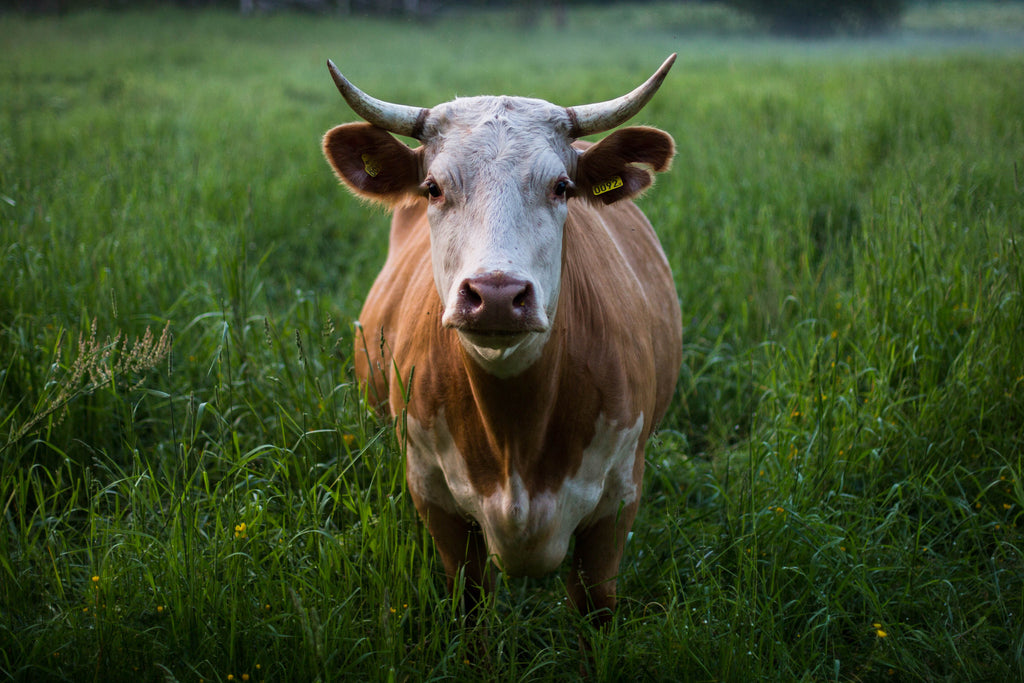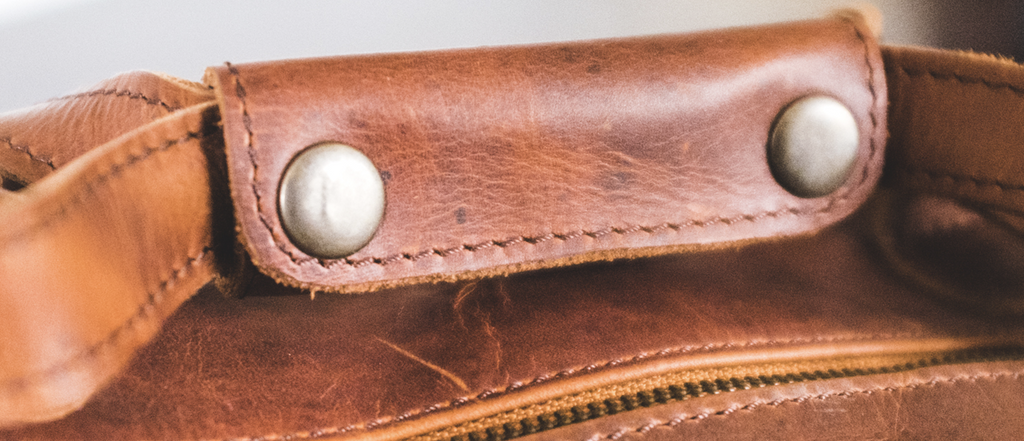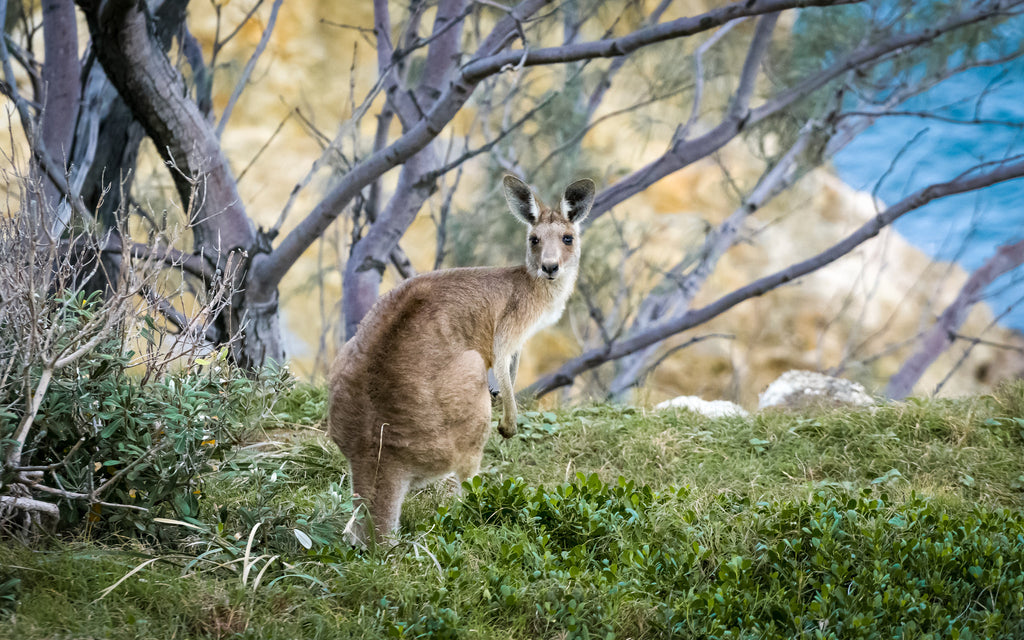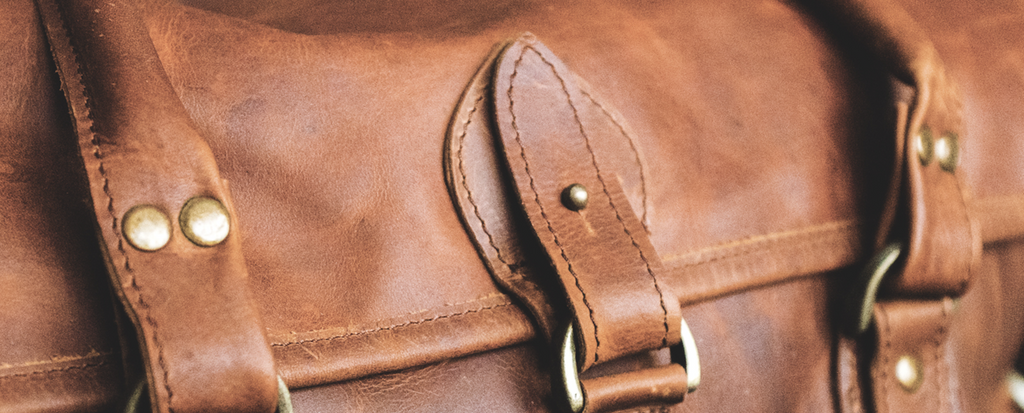What is full grain leather and why do we use it?
Table of Contents
There are few more important considerations for a leather brand than in deciding which cut to choose. Here’s a little bit about full grain and why we felt it was the best choice for many of our designs.
What is Full Grain Leather?
Full grain refers to the strongest and most durable part of the hide of an animal, which is just below the hair and has not been sanded, buffed or snuffed (as opposed to corrected grain) which means it displays the more natural characteristics of leather.
As the grain surface is left intact before applying the surface coating, the leather has more fibre strength and durability and as it ages, it will develop a patina (see below) over time. Full grain leather often comes with an aniline finish which stains or dyes the leather while still allowing the natural grain to show through, this subtle finish allows the leather to continue to breathe, as opposed to other types of leather which are sanded down and given a thicker finish coat.
Full grain is regarded as the highest quality leather, which is why ultimately we choose to use it for many of our bags and accessories
What Does Full Grain Leather Look Like?
Full grain leather shows all its natural markings and blemishes which many argue adds character to the material.

Being the strongest, outermost layer of the hide to be used, and keeping the grain in its entirety, rather than being sanded away to look more ‘uniform’, full grain leather lasts much longer. As it ages, it develops a patina, which is the change in colour over time. This change occurs faster on untreated pieces and is considered to be a highly desirable characteristic of leather.
On the smooth, unaltered surface, you can even see the pores and small hair follicles (if you use a magnifying glass), which indicates that the leather is of a high quality. Other characteristics to take note of are fat wrinkles or growth lines, natural variations in the grain texture, shading and small scars.
Every hide is unique as it comes from a different animal with different markings and blemishes so when looking at or working with full grain leather you’ll soon realise that no two hides are exactly the same.
What Does Full Grain Leather Upper Mean?
Full grain leather uppers are leather uppers which have been made from full grain leather. When talking about a ‘leather upper’ we’re talking about the part of a boot or shoe above the sole that is made from leather.
Where Does Full Grain Leather Come From?
Full grain leather comes from the layer of skin just under the hair and is made from the outermost layer of the hide which means it’s more durable as the structure of the fibres are much more tightly interlinked.

Full grain leather can come from goats, pigs, sheep and even more exotic animals such as alligators, ostriches and kangaroo. However cattle skin is the most commonly used skin to make leather with. Any product on our website that is listed as full grain leather, comes from cow hides only. You can read more about where we source our hides here.
How is Full Grain Leather Made?
The process of making leather features 3 main stages: preparation, tanning and crusting. A fourth step may also be added where the leather is given a surface coating or finish.
Preparation:
Firstly, the animal skin, or hide, is prepared, this may include some of these steps:
- The skin is treated to preserve it and make it temporarily imputrescible.
- It is then soaked to clean and rehydrate it.
- Then comes the operation of liming which is the removal of proteins and natural fats and greases by soaking it in an alkali solution.
- Then the hair of the skin is removed followed by the removal of subcutaneous materials and fat.
- The hide is split into horizontal layers, which gives us different layers like full grain (top layer) to the corium layer from which ‘genuine’ leather and suede are made.
- The skin is limed and de-limed, the further removal of proteins and then the removal of those chemicals. More proteins are removed through bating when proteolytic proteins are introduced; this also helps to soften the pelt.
- It then goes through a subprocess called slicking which is the physical removal of fat inside the skin.
- The hide is then bleached and pickled (lowering of the pH level to the acidic region) to help certain tanning agents to penetrate it; it may then be de-pickled to raise the pH level up again to assist with the penetration of further certain tanning agents.
Tanning:

Next the hide is tanned, which is the process of turning the raw hide into a stable material that will dry out to a flexible form and won’t putrefy. There are various methods of tanning, which one is used depends on the final application of the leather, the most common tanning material used is Chronium. We only use vegetable dye (free of Chrome VI) on our leather.
- The hides are put into a drum along with the tanning liquor to soak while the drums slowly rotate.
- Once an even amount of penetration has been acquired, the pH levels are slowly increased - this sub-process is called basification.
- Basification fixes the tanning material to the leather.
Crusting:
The tanned hides then go through the crusting process, which is when the hide is thinned, tanned again and lubricated. Crusting is also when the colouring process often comes in. The main aim of crusting is to dry and soften the hides.
The leather may also be given a surface coating or finish:
- Oiling
- Brushing
- Padding
- Spraying
- Buffing
- Embossing
- Glazing
These are all operations that may be performed if the leather requires a finish. For example, patent leather would be given a super glossy, shiny finish.
Where to Buy Full Grain Leather
Full grain leather, as it is, can be bought from tanneries and leather merchants all over the world and online. The eight biggest producers of leather in the world are: the USA, Argentina, South Korea, India, Russia, Italy, Brazil and China. Staying true to our namesake, all of the full grain leather used to make MAHI products comes from India.

What is Pebbled Leather?
When we talk about pebbled leather, we’re talking about leather that has had a pebbled texture embossed onto the surface. Adding this texture is for cosmetic reasons and is used to hide the natural flaws on the surface of the leather.
What is Burnished Leather?
Burnishing is a finishing technique where the leather is smoothed, by applying pressure and friction, and is given a darker, more antiqued colour. Leather is often burnished on the edges using a metal tool, such as a spinning disk.
What is Oiled Full Grain Leather?
Oiled leather has been coated with oils such as raw (un-emulsified) oil or a combination of raw oil, blended with emulsified oils and a penetrating aid. Oiling hydrates the leather, allowing it to flex and be lubricated and also helps to make the leather water resistant. The process is often associated with full grain aniline leathers.
What is Tumbled Full Grain Leather?
Tumbling is a way to treat leather and make it softer. This process is carried out in the drum to create a more evident grain and smooth surface.
How to Maintain Full Grain Leather?
Full grain leather is fairly low maintenance. In fact, with our bags we suggest simply wiping your bag down with a cloth every now and then to avoid the build up of dust and dirt. The most important thing about maintaining full grain leather is how it is stored. You should never place any leather product near the radiator or use a hair dryer on it as this can dry out the leather. Another tip for keeping leather soft is keeping it in a humidity controlled environment of about 40-50% to allow it to maintain its essential moisture.
There are hundreds of products available online made for cleaning, waterproofing and conditioning leather, which are all good ways of keeping up the quality of your product. Although it’s nice to embrace the natural changes and ageing of leather, you may want to invest in a suitable leather cleaning product and/or conditioner (extra virgin olive oil acts as a great conditioning alternative) to keep the leather soft and supple. Just rub the product into the surface of the leather, not dissimilar to moisturising your face, to allow it to soak into the pores. This also helps to stop the leather becoming stiff and drying out.
Please note: it is advised that you always patch test a new leather care product on an inconspicuous area of the leather before applying it all over, as some products may alter the colour of the leather in a way you are not happy with.
How to Protect Full Grain Leather?
Leather protectants and sealants coat and protect the top layer of the skin and aid in stopping natural oils from escaping as well as the moisture to keep it supple. Applying polish to leather is a matter of personal preference and opinion but it can offer further protection in the form of an additional barrier for everyday dirt and grease.
How to Waterproof Full Grain Leather?

Leather is a permeable material and can therefore never be 100% waterproof. It is recommended that you oil your full grain leather as this aids with waterproofing. A beeswax or spray protector can also be used, but as with any new leather care product, you should always test a small amount of the product on an inconspicuous area of the leather product first to ensure you’re happy with the finish and colour. (Some protectants can alter the natural colour of leather). These will create a barrier over the leather. If your leather does get wet, do not place next to a radiator or attempt to dry with a hair dryer as this will dry out the leather.
How Long Does Full Grain Leather Last?
Full grain leather is extremely durable and typically lasts 5 times longer than fabric. With the correct care, and dependent on usage, full grain leather can last decades.
How Thick is Full Grain Leather?
The thickness of full grain leather depends on the way it has been made and for what purpose. Tanned hides are usually split into 2 or more sheets so this is also a factor to consider. The strength of full grain leather comes from the tightness of its fiber structure, rather than its thickness. The lower leather cuts have a looser fiber structure and are considerably less durable.
Full Grain Leather Versus Corrected Leather
While full grain leather is the outermost layer of the hide with the epidermis intact and showing all blemishes, corrected grain leather is just that, a top grain leather which has been ‘corrected’ through buffing and sanding to remove the top layer of blemishes due to brands, healed scars or insect bites. It is then stamped or embossed with an artificial grain. Corrected grain has a much smoother and more uniform appearance but is of lower quality and has a more plastic look and feel to it.
Kangaroo Leather

Kangaroo leather is commonly used for, but not limited to, making shoes, especially soccer cleats, laces and whips. It has a different fiber structure to cowhide and it is split into thinner layers because it retains a lot of its original tensile strength and it’s quite stretchy. However, due to the thinness of kangaroo leather, it often doesn’t last as long as full grain cowhide and it isn’t water resistant.
Calfskin Leather
Because calves aren’t as mature as cows, they’re skins are much smoother and have less markings and blemishes on them. Calfskin leather is thin and has a smooth appearance with a fine grain yet still holds a certain durability as its fiber structure is more tightly interwoven than cows’. Calfskin is much better at maintaining its shape and is also waterproof. Because calfskin is thinner and more lightweight than full grain cowhide, it isn’t as durable.
Bonded or Blended Leather
Bonded, or blended, leather is made by processing scraps of genuine leather and creating sheets out of them to stick together. It is then embossed to give it an artificial grain. Bonded leather is considered low quality leather, and is considerably less durable than full grain leather. Unlike full grain, bonded leather doesn’t form a patina over time and it’s also very difficult to repair.
Full Grain/Top Grain Leather Versus Split
Hides are initially split into two layers - the top/grain layer and the split layer. The grain layer is used to make full grain, top grain, corrected grain and nubuck leather; it generally lasts longer, is stronger and ages better than split leather. Split leather has a loose fiber structure and is commonly given a printed texture to mimic grain leather. Split leather is also used to create suede.
Full Grain Versus Genuine Leather
The term ‘genuine leather’ can be misleading consumers because although it is made with real leather, the leather used is of a low quality made from split leather, which is weaker than full grain leather. A lot of people see ‘genuine leather’ and think it’s synonymous with good quality leather but this is often not the case. Full grain leather is made from the top layer of the hide and is the regarded as the highest quality leather.
Suede and Nubuck

Suede and nubuck leather are very similar and both go through an abrasion process which creates their velvety nap. However, there are some differences in their quality - nubuck leather comes from the grain leather of a hide and so is tougher and slightly more water resistant than suede, whereas suede comes from the split layer of the hide and so is weaker due to it’s loose fiber structure, this also means that the nap on suede isn’t as fine as it is on nubuck leather. In comparison to full grain leather, suede and nubuck have a different feel and appearance from the abrasion process and are also less durable.

















